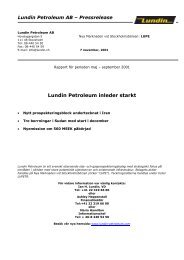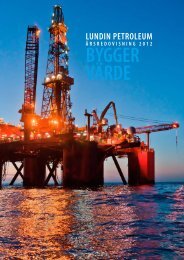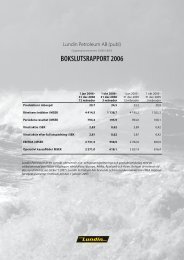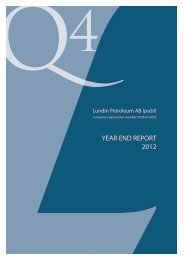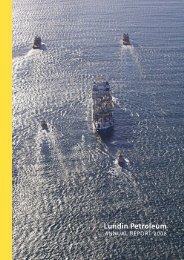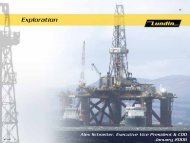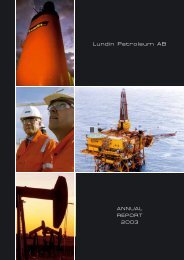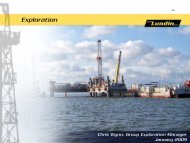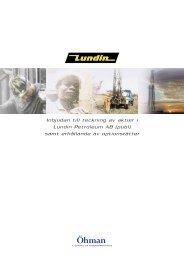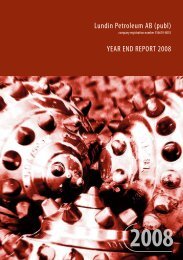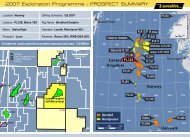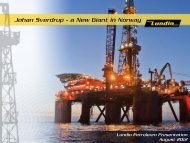Annual Report 2005 (6 MB) - Lundin Petroleum
Annual Report 2005 (6 MB) - Lundin Petroleum
Annual Report 2005 (6 MB) - Lundin Petroleum
You also want an ePaper? Increase the reach of your titles
YUMPU automatically turns print PDFs into web optimized ePapers that Google loves.
MARKET DESCRIPTION<br />
World Oil Production 2004<br />
North America<br />
18%<br />
Russia/Caspian<br />
14%<br />
Asia Pacific<br />
10%<br />
Russia/Caspian<br />
28%<br />
Africa<br />
5%<br />
Africa<br />
11%<br />
South & Central<br />
America 8%<br />
Middle East<br />
31%<br />
Europe<br />
8%<br />
Total Production 80.3 million bopd<br />
World Gas Production 2004<br />
North America<br />
28%<br />
South & Central<br />
America 5%<br />
Europe<br />
12%<br />
Middle East<br />
10%<br />
Asia Pacific<br />
12%<br />
Total Production 2,691.6 billion m 3<br />
World Oil Reserves End 2004<br />
112 101<br />
Africa<br />
South & Central America<br />
Source: BP Statistical Review of World Energy <strong>2005</strong><br />
17<br />
734<br />
41<br />
61<br />
123<br />
Europe<br />
Middle East<br />
Asia Pacific<br />
North America<br />
Russia/Caspian<br />
> 8 <<br />
GLOBAL RESERVES<br />
Crude oil<br />
Crude oil is found on all continents of the world. The Middle<br />
East is by far the region where the largest proven oil reserves<br />
are found, followed by Russia/Caspian and Africa. In total,<br />
global proven oil reserves amounted to 1,189 billion bbls at<br />
the end of 2004, of which 62 percent was attributable to the<br />
Middle East.<br />
Natural gas<br />
As well as oil, natural gas exists on all continents. However, the<br />
reserves of natural gas are distributed diff erently compared<br />
to the oil reserves. At the end of 2004 there was 179.5 trillion<br />
m3 of proven natural gas reserves, of which the Middle East<br />
had 40 percent and Russia/Caspian 32 percent.<br />
The growing gap<br />
The world has up until now been supplied by oil discovered<br />
particularly from 1950 through to the 1970. Despite<br />
signifi cant improvements in technology the industry has<br />
not discovered enough new reserves to replace the oil being<br />
consumed since the mid 1980s (see World Oil Demand<br />
graph). The International Energy Agency (IEA) estimates that<br />
global oil production will increase by less than one percent<br />
up to 2030.<br />
Competition - Partners<br />
The players in the oil and gas market consist of national oil<br />
companies (eg. Aramco, CNPC, Petronas, Statoil), the big<br />
integrated oil companies, the majors (eg. Exxon, Shell, BP)<br />
and independent oil companies such as Talisman Energy,<br />
Tullow Oil and <strong>Lundin</strong> <strong>Petroleum</strong>.<br />
The main strategy of the national oil companies is to secure<br />
the energy supply for their respective countries. They often<br />
have downstream operations i.e. refi neries and distribution<br />
network/petrol stations.<br />
14.1<br />
World Gas Reserves End 2004<br />
7.1 5.8<br />
72.8<br />
14.2<br />
7.3<br />
58.2<br />
Africa<br />
South & Central America<br />
Europe<br />
Middle East<br />
Asia Pacific<br />
North America<br />
Russia/Caspian<br />
Total Oil Reserves 1,189 billion bbls Total Gas Reserves 179.5 trillion m 3



